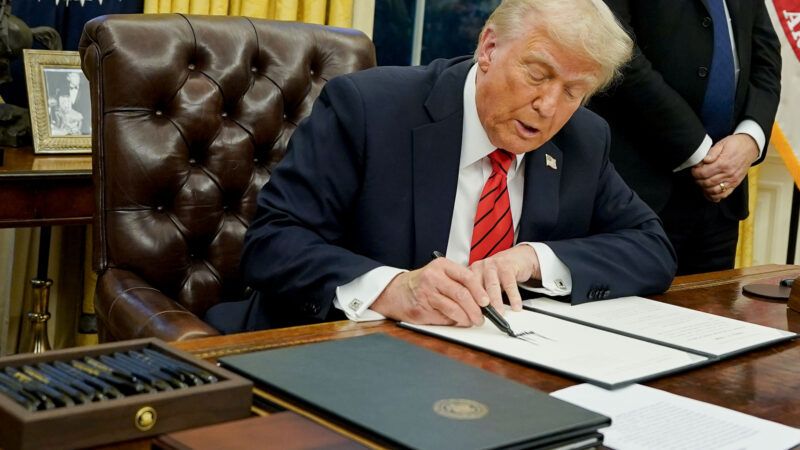Trump's 'Reciprocal' Tariffs Could Be Largest Tax Increase Since World War II
The specifics are still vague, but the White House is reportedly claiming that new tariffs will generate $1 trillion annually.

President Donald Trump outlined plans on Thursday to overhaul America's entire system of tariffs in order to charge what he calls "reciprocal" taxes based on the country where goods are sourced.
If the White House's preliminary assessment is accurate, it would be the largest tax increase on Americans since World War II—and one that Trump would apparently seek to implement without congressional approval.
The specifics of Trump's reciprocal tariffs plan remain sparse. The executive order Trump signed Thursday instructed the Department of Commerce and the U.S. Trade Representative to develop new proposed tariff levels that take into account the tariffs charged by other countries to import American goods, as well as industrial subsidies, value-added taxes, and other economic policies that Trump views as unfair. It will take weeks (and perhaps longer) for the new tariffs to be calculated and rolled out, and the changes may be implemented on a country-by-country basis, according to Megan Cassella, a reporter for CNBC.
Regardless of how it shakes out, it seems like Americans will be facing a massive tax increase. "White House officials claim that the new policy could yield up to roughly $1 trillion in new annual revenue," the Washington Examiner reported.
That number seems a bit absurd. America imported about $3.3 trillion of goods last year, so achieving $1 trillion in new tariff revenue would require tariffs to be set so high that they would severely reduce imports—thus reducing the revenue from tariffs. Think of it as a reverse Laffer curve. That's one reason why tariffs are a poor way to generate revenue.
Still, if that's the figure the White House is going with, let's call it what it is: The largest tax increase since World War II, as a share of America's gross domestic product (GDP). Total American GDP was about $29 trillion last year, so a $1 trillion tax increase would consume about 3.4 percent of the economy, making it the largest tax increase since the Revenue Act of 1942.
If those numbers are true, then Trump's new tariffs would also dwarf the tax increases that Kamala Harris supported during last year's presidential campaign—her various proposals would have generated a paltry-by-comparison $1.7 trillion over 10 years, the Tax Foundation estimated.
The direct costs of taxes on so many imports would be only part of the problem. Trump's idea of charging different tariffs on every country's exports means the same product could be charged wildly different tax rates depending on where it was sourced. Those tariff rates would also be subject to constant fluctuation, as other countries shift their policies—as many will likely do in response to Trump's new tariffs. That's a recipe for not only higher taxes on American businesses that rely upon imports but also a constant state of uncertainty.
But for Trump, it all seems pretty straightforward.
"If you build your product in the United States, there are no tariffs," the president said during his remarks in the Oval Office.
That's simply not true. Many products manufactured in the United States depend on components and raw materials sourced from abroad. Even those that don't may raise their prices—thanks to the higher prices that competitors will be forced to charge due to any new tariffs.
It all points to an obvious conclusion: As with the rest of Trump's ill-considered trade policies, it is American businesses and consumers that will bear the cost of these higher tariffs.
The only silver lining to Thursday's proposal is that it will take a while to develop the specifics of the plan. Commerce Secretary Howard Lutnick said the new tariffs won't be implemented until at least April.
That means there is still time for Trump to change course and avoid a costly trade war that would hit Americans squarely in the wallet.


Show Comments (112)